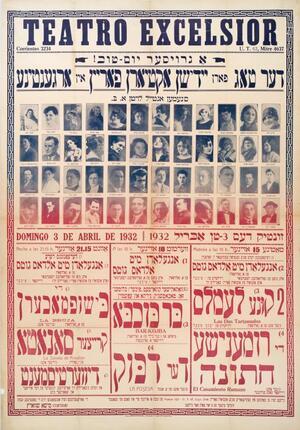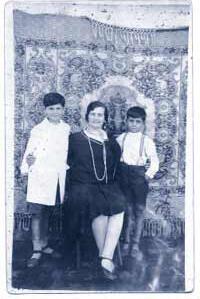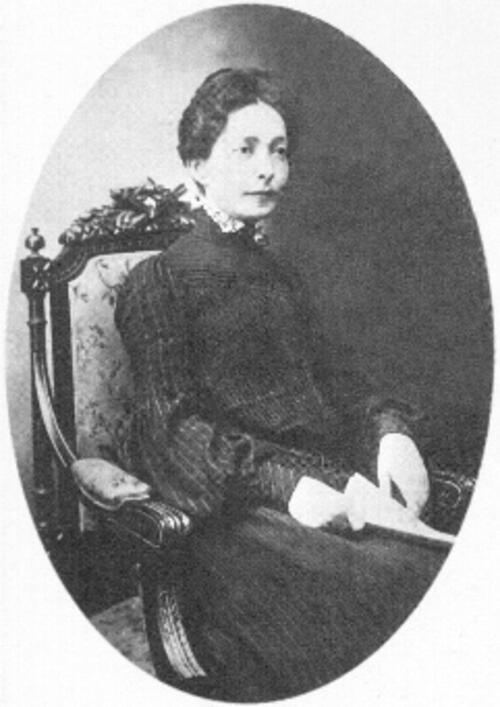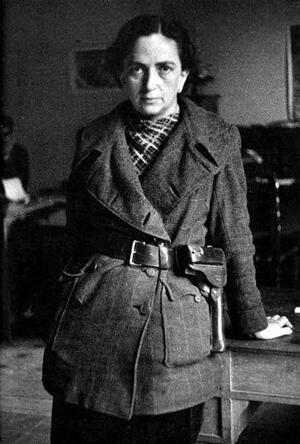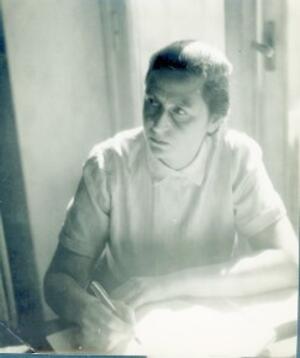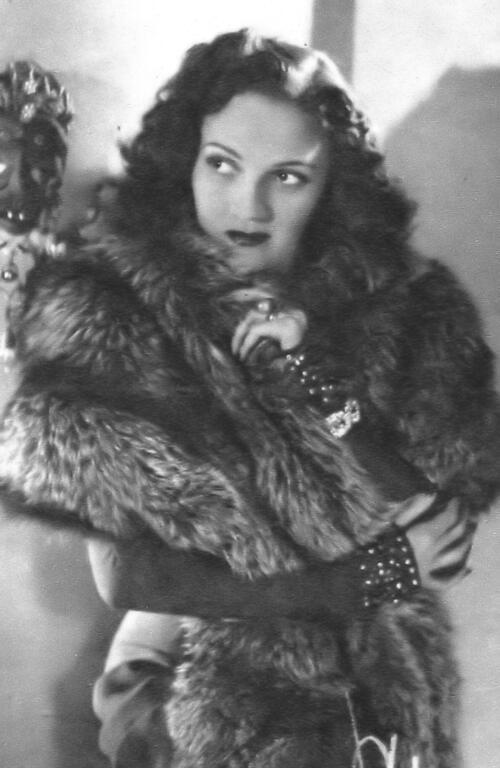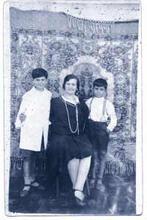Argentina: Jewish Women
Argentina today has the largest Jewish presence in Latin America and the third largest in the Western Hemisphere. Before 1889, a small number of relatively well-off Jews from Western Europe, as well as a small number from Morocco. Following them were Jews from Eastern Europe, the Balkans, Turkey, North Africa, Syria and other parts of the Middle East. By the 1960s, the Jewish population reached a height of 310,000. Jewish women helped build families, communities, and identities. As pioneer farmers, political activists, union members, performers, human rights advocates, and prostitutes, Jewish women participated in some of the most dramatic aspects of Argentine history. They created ideals of social justice that continue to inspire Jews and Catholics alike.
Argentina has the largest Jewish presence in Latin America and the third largest in the Western hemisphere. It features sizable numbers of Sephardim, North Africans, and Arabic speakers, aside from the Ashkenazic majority. Jewish women have been active in farming, education, the professions, the arts, and the prostitution trade. Stretching from the countryside to the cities, the organizations they created helped fill communal needs. They have been major participants in labor unions, leftist parties, and other movements that have struggled for democracy and human rights.
Jewish Immigration
Argentine Jews form a set of communities of diverse cultural origins. A few relatively well-off Jews arrived from Western Europe before 1889, as did a small number from Morocco. In that year, a mass migration from the Russian empire began. A significant number of the Eastern Europeans became farmers on lands acquired by the Jewish Colonization Association (JCA). Most, however, eventually moved to the cities, where they met others who had settled there directly upon arrival. Starting out as laborers and peddlers, some Eastern European men managed to establish small businesses and industries. The Eastern Europeans and their descendants form the majority of Argentine Jews. Jews also came from the Balkans, Turkey, North Africa, and Syria and other parts of the Middle East before 1930. Establishing themselves in small towns as well as larger cities, many men from these groups became peddlers and merchants, and a few became textile manufacturers. Central Europeans and Italians fled their homelands for Argentina during the Nazi era. Most men of these backgrounds entered the professions and light industry, but a few German-speaking families settled in JCA colonies. After World War II, a handful of Holocaust survivors and Jews from Morocco and Egypt migrated to Argentina, completing the set of Jewish communities.
The Jewish population reached a height of 310,000 in 1960. Thereafter, intermarriage and a low birthrate reduced its numbers. Moreover, continual economic and political turmoil convinced many Jews to move to other countries, particularly Israel and the United States.
Jews constituted only a small part of an immense flow of immigrants to Argentina. Most of the newcomers who came to this South American nation were Italian or Spanish. Their cultural backgrounds were similar to that of the host society and, like most native-born Argentines, they were Catholic. Thus, Jews stood somewhat apart in an immigrant nation that was more homogeneous than that of the United States.
For the first few years after 1889, most of the immigrants from the Russian empire headed for the JCA colonies. The JCA handed out a plot to each family, and if it managed to farm effectively and pay off the terms of the JCA contract, it received title to the land. Although this venture required effort from every family member, both female and male, the JCA awarded the titles only to male household heads. The few female titleholders were widows who inherited deeds from their husbands.
The Argentine environment and JCA practices impeded success. JCA lands were marginal and prone to natural calamities, and the plots were not large enough to establish viable ranches or arid-zone farms. The JCA frequently ejected farmers who failed to keep up with their payments. By refusing to distribute land from its reserves to the colonists’ children, it insured that Jewish rural life would be transitory. During the Nazi era, precisely when Jews needed refuge, the colonizing organization made it difficult for candidates to acquire land. It is not surprising that many of the treatments of Jewish agricultural life in Argentina focus on conflicts with the JCA and the creation of cooperatives to gain leverage against it.
Work, Social Life, and Education
Women hardly figure in such histories. Their lives revolved around their homes, farms, and schools. Fetching water, washing, ironing, cleaning, and rearing children were arduous tasks in these surroundings. Women tended vegetable gardens, fruit trees, and poultry; they often milked cows, made cheese and butter, and sold the products of their labor. Sometimes they worked in the fields and cooked for the peons who helped harvest the crops. They also served as intermediaries between the (Yiddish) Small-town Jewish community in Eastern Europe.shtetl and Argentine cultures, gathering information from Creole (poor native-born Catholic, often mestizo) women who worked for them in the home or lived nearby. Jewish children often learned Spanish in the schools before their mothers did.
Socializing with neighbors formed a welcome part of the routine. Work exigencies and distance limited visiting to weekends and holidays. Hundreds of guests congregated at weddings, where they dined on foods prepared by the bride’s female relatives. Parents, marriage brokers, and pious elderly ladies arranged matches for young single people and widows. Over time these arrangements gave way to relationships formed by men and women themselves, who became acquainted at weddings, dances, picnics, and libraries. Instances of Creoles raping or “kidnapping” young Jewish women were not unknown; given the norm of endogamy and the low regard many Jews had for the uneducated Creoles, stealing away under the guise of kidnapping was perhaps the only way for a Jewish girl to marry one.
Libraries performed vital social and intellectual functions. Often unable to complete more than a few years of formal schooling, young women borrowed books in Yiddish and Spanish to round out their education. More than simple book repositories, however, the libraries hosted lectures and literary and political discussions avidly attended by young men and women. They held dances, performances of visiting artists, charitable functions, and amateur theatrical presentations. Women volunteered to work in these institutions, served on their boards, and participated in the activities they hosted. Socialist Fenia Chertkoff, for example, founded the library in Colonia Clara, Entre Ríos.
In 1914 fewer than half of the Russian-born women in Argentina were literate. The struggle to acquire an education helped define women’s lives. Children often had to walk or ride a horse or carriage long distances to attend the first few grades at a rural school. For girls, instruction in dressmaking sometimes supplemented the lessons in Spanish and Yiddish. They perfected their reading and listening skills with their families by spending evenings reading aloud. The JCA sometimes offered basic courses at night for adults, but propriety and fear for women’s safety often led it to exclude women from them. Any schooling beyond the very elementary level meant taking correspondence courses or moving to a city and living with relatives or in a boarding house. Unwilling to spend scarce funds, lose their daughters’ labor, risk the possibility that they would forsake Judaism, or challenge customary gender roles, parents often did not encourage them to seek education. Despite this obstacle, some young women managed to leave home, attend normal school, and become teachers, following the typical path of upward mobility for Argentine women. (See Argentina: Jewish Education)
Other than teaching and marriage, few career options were available for young women in the rural milieu. Some women worked as midwives, others labored in family-owned stores, and a few were prostitutes. A handful of exceptional women served their communities as nurses and doctors.
The lack of educational and professional opportunities, as well as difficulties imposed by the JCA and local environment, led most colonists to migrate to urban areas. At the same time, other Jews from the Russian and Ottoman empires headed to Buenos Aires and, to a lesser degree, other large cities. While they tended to set up businesses and homes in certain neighborhoods in Buenos Aires (indeed, Eastern European and Mediterreanean Jews resided or worked side by side in some of these), none became ghettos. The presence of Argentines, Italians, and Spaniards facilitated cultural exchange and the acquisition of Spanish. Meanwhile, some Moroccans had scattered through towns in the interior, where they established general stores. Their prior knowledge of Spanish and dispersal pattern also enhanced their adaptation to life in Argentina.
Often arriving after their husbands, Moroccan and Ladino- and Arabic-speaking women mainly were homemakers, although this did not necessarily exclude income-earning activities. Their menfolk tended to send for their wives and children or return to their homelands to marry and bring their brides back. Some of these women had studied in schools of the Alliance Israélite Universelle. Once in Argentina, they dedicated themselves to their families, although many “helped” their husbands in their businesses, without pay, or earned money sewing and embroidering within or outside their homes. It was more common for their daughters to work outside the household. Education for girls usually ended at the primary or normal school level, sometimes supplemented by vocational and musical courses.
Initially, Mediterranean women associated largely with their families and communities of origin. The extended family network was the center of social life. Persons from a particular city or region, such as Rhodes or Aleppo, set up their own synagogues, charities, and clubs. Cementing these identities, women conversed in the temple balconies on the high holy days, distributed alms to the poor, and attended dances in the clubs. Only by the 1940s did they begin to transcend these boundaries to forge a generalized Sephardic identity.
Aside from their home life, prosperous Eastern European women involved themselves in social clubs and philanthropic groups. The most prestigious charity was the Sociedad de Damas Israelitas de Beneficencia (Society of Israelite Beneficent Ladies). At its fundraisers and events of the Sociedad Hebraica Argentina (Argentine Hebraic Society), the club of choice, well-dressed bourgeois women could display their status. Some of their daughters finished secondary schools and even the university.
These women contrasted with the working-class Eastern Europeans, mostly Polish, who arrived after 1918. Having labored as seamstresses, tailors, weavers and pressers in Poland, they found similar positions in the burgeoning textile and clothing industries of greater Buenos Aires. Located in or near some of the neighborhoods where Jews congregated, the sweatshops and factories often were Jewish-owned.
Jewish Prostitution
Women were also involved in sex work in the late nineteenth and early twentieth centuries. Jewish pimps offered money to poor families in the Russian Empire to marry their daughters and transported these women to brothels in Argentina and other countries. Their wives, mistresses, and female relatives also recruited and trained women for the trade, and they frequently ran the brothels and guarded their inmates. Jewish pimps and madams belonged to the infamous Zwi Migdal, which bribed law enforcement officials and politicians and offered religious and burial services for its members, whom the Jewish community ostracized. To curb this trade, a local branch of the Jewish Association for the Protection of Jewish Girls and Women, eventually known as Ezras Noschim, arose in 1901. Ezras Noschim urged criminal prosecution of the Zwi Migdal and tried to pry women out of its clutches. By the mid-1930s Heléne R. de Aslán, officer of the Sociedad de Damas, had become its head.
The judicial system finally began to prosecute the Zwi Migdal in 1930. In that year former prostitute Raquel Liberman, aided by Ezras Noschim, complained to the police, and her case expanded into a larger inquiry into the Zwi Migdal. Some of its members fled the country, while the authorities deported others. Although the city of Buenos Aires banned prostitution in the 1930s, brothels, some of them managed by Jewish women, continued to operate clandestinely in the capital and interior, and Jewish and other prostitutes still sought clients at cabarets and bars.
Yet Jews did not outnumber other prostitutes, nor were they necessarily innocent “white slaves.” Many Jewish women had already engaged in this work in Europe; others turned to it because alternative employment was scarce and poorly paid. While Jews may have constituted a majority of legally registered prostitutes in the early twentieth century, the official statistics did not take into account the prostitutes who had not registered. Among them, the percentage of native-born Catholic women was high. Finally, Jewish participation in the trade declined over time.
Life for other Eastern European working-class women was also difficult, but it brought some rewards. Most lived with other family members in crowded one-room apartments. Girls generally were able to attend public school for at least a few years, while women learned Spanish in the neighborhood or at work. Rarely attending synagogue, they centered their social life on the family, leftist clubs and libraries, landsmanshaftn, and Jewish theater. Some of the women experienced upward mobility as their family-owned workshops expanded into factories. Whether as members of the working class or wives of new industrialists, most would attain greater prosperity by the late 1940s, during Juan Perón’s presidency.
Union and Political Involvement
Some women fought for a better life through the union struggle. One of these was Fenia Chertkoff, who with other Socialist women in 1903 founded the Trade Union of Women, a union drawing upon women of all trades. It only lasted four years. Labor activism expanded after World War I with the arrival of the Polish women, who had union experience. Born in Poland, Guitl Kañuki landed in Buenos Aires in 1924. Almost immediately this tailor and seasoned militant joined a union and in her column in a Yiddish-language daily exhorted women to organize. A former Bund member and Communist party sympathizer or adherent, Kañuki led a demonstration of women workers on May Day 1929 and participated in the apparel industry strikes of 1930 and 1934. Her union later joined the Communist-led Federación Obrera del Vestido (Labor Federation of the Garment Trade), whose female commission in the 1930s included several other Jews.
Jewish women were also active in other unions. One was the Unión Obrera Textil (Textile Labor Union, or UOT), dominated by Socialists until 1939 and by Communists thereafter until the mid-1940s. A skilled weaver from Poland whose parents had been revolutionaries, Dora Genkin entered the union in 1936 and became the secretary of its female commission, marrying the Communist textile worker leader in the process. She wrote in the UOT newspaper, spoke at its gatherings, and addressed Communist women’s groups and the congress of the Confederación General de Trabajadores (General Confederation of Workers) in 1942.
The union struggle was linked to leftist movements, and women of Eastern European backgrounds played roles in the Bund, anarchism, Socialism, and especially Communism. Little is known about women in the Bund beyond the fact that it had a women’s center. Active in cities and rural zones, Jewish female anarchists also remain to be studied. In both areas they participated in anarchist cultural events and took traveling anarchists into their homes. In the city of Santa Fe, Russian immigrant Rosa Dubovsky founded a women’s anarchist center and helped organize female match factory workers in the early 1900s. Her daughter Sara and other urban anarchists demonstrated on behalf of political prisoners and visited them in jail; Sara also wrote an article for Nuestra Tribuna, the anarchist women’s periodical of the 1920s. Some Jewish anarchist women belonged to small Yiddish-speaking circles such as the Yidishe Ratsionalistishe Gezelshaft in Buenos Aires; less interested in maintaining a Jewish identity, others joined larger, Spanish-speaking groups. Still others moved from anarchism to different revolutionary currents. One was former anarchist and Communist Mika Feldman de Etchebéhère, who captained a Trotskyist regiment in the Spanish Civil War and was active in the anarcho-feminist organization Mujeres Libres in Spain.
The story of Jewish women’s participation in the Socialist party is largely intertwined with that of one family, the Chertkoffs. Fenia Chertkoff and her two sisters married prominent Socialists, as did Fenia's daughter from her first marriage, Victoria Gucovsky. Apart from those of her activities already mentioned, Fenia wrote and translated for Socialist periodicals; founded the Centro Socialista Femenino (Socialist Feminine Center) in 1902; lobbied for legislation protecting female and child workers; and inspected factories to insure compliance with labor laws. One bill she helped author, requiring employers to provide chairs for female workers during rest periods, became law in 1919. While she supported the vote and other civil rights for women, Fenia's feminism emphasized the workplace. This indefatigable woman also created a network of after-school programs for working-class children.
An author and high school teacher, Gucovsky frequently addressed socialist and female audiences on cultural topics and wrote for socialist periodicals in the 1920s and early 1930s. She was a leader of the peace, adult literacy, and female suffrage movements. Other Jewish women contributed articles to socialist periodicals; gave lectures in and attended socialist-sponsored worker education programs; organized children's activities; and by the 1930s campaigned for party candidates.
Jewish women were especially conspicuous in the Communist party, playing critical roles in labor and student groups, groups that demonstrated solidarity with political prisoners, and the cultural realm. A number of Jewish Communist women went to Spain to participate in the Civil War. One of these was Fanny Edelman, who went on to become secretary-general of the Unión de Mujeres Argentinas (Union of Argentine Women), a front group, and member of the party Central Committee. A prominent space for Jewish women was ICUF (Yidisher Kultur Farband), the Argentine branch of the Soviet-sponsored global organization, founded in 1937, which promoted a progressive Yiddish-based Jewish identity divorced from religion or Zionism. ICUF ran schools, children’s clubs, summer camps, cultural offerings, and a publication series, and women were involved in all of these endeavors. They also established women’s reading circles; published a magazine entitled Di Idische Froi, beginning in 1951; and awakened women to broader issues of interest to the party, such as opposition to the arms race during the Cold War. The ICUF women’s sector concentrated its efforts on homemakers generally ignored by Communist leaders, thus complementing the party’s recruitment strategy toward women.
Music and Theater
The Yiddish theater provided diversion and an outlet for working-class women’s creativity. Yiddish plays debuted in Buenos Aires in 1901, and initially their main patrons were members of the Zwi Migdal. By 1930 the prostitution ring had fallen apart, the theatrical audience had expanded, and the city was among the four greatest centers of Jewish theater in the world. Aside from commercial theatrical companies, the Yidisher Folks Teater (IFT), tied to the Communist party and, later, ICUF, arose in 1932.
The IFT and the Yiddish theater in general served as springboards to careers on the Argentine stage and screen. Golde Flami and Cipe Lincovsky were among the IFT actresses who went on to star in Spanish-language plays, films, and television programs. Another renowned performer who emerged from the Yiddish theater was Berta Singerman, who became the premier reciter of poems in the Americas.
Not connected to the Yiddish theater, but tied to Yiddish culture through her father, a prominent Jewish educator, was the musical and media personality Paloma Efrón. After studying Black culture and music in the United States, “Blackie,” as she was called, became a popular jazz singer in the 1940s. In 1952 she moved to television as a singer, interviewer, and host and producer of her own long-running show.
German, Italian, Moroccan, and Egyptian Communities
The Central Europeans and Italians who found refuge in Argentina in the 1930s and 1940s faced challenges that differed from those encountered by the Eastern Europeans. A few German speakers headed to the colonies, but the girls tended to leave the countryside for Buenos Aires, remitting earnings that enabled their families to remain on the land. In the capital, these and other young German-speaking women found jobs as nursemaids, governesses, servants, secretaries, and dressmakers. Their mothers tended to work in the home, in dressmaking, or in family-owned enterprises. The women’s arm of the German-speakers’ aid society, the Frauenhilfsverein, helped the needy and provided day care for working mothers. When time permitted, the Central Europeans attended their own clubs, synagogues, and the theater of the German-language exiles. Generally well-off, Italian homemakers rarely had to seek jobs outside the household. Central European and Italian girls were more likely to study and work professionally if they arrived at an early age; the older ones found it difficult to revalidate their degrees. Few of those who arrived as adults achieved professional renown in Argentina. Among the exceptions were Eugenia Sacerdote de Lustig, an Italian medical doctor known for her research in cellular biology; Marie G. de Langer, a Viennese psychoanalyst; and Hedy Crilla, an Austrian director and actress who trained many Argentine actors who later achieved fame.
A small number of Holocaust survivors, Moroccans, and Egyptians arrived in the years after World War II. These immigrants tended to mix with related groups that had migrated earlier. Their arrival marked the completion of the Jewish communities.
Professional Careers
For Jewish women of all backgrounds, the usual entree to the professional world was teaching at the primary level. Graduating from a normal school propelled young women into a lifelong career or other options. Sometimes they studied at the university while they taught, or, after teaching for a while, became school administrators.
Other Jewish women entered the professions without a teaching apprenticeship. Although one who had studied medicine in Europe began practicing in Argentina in the 1890s, the first locally trained Jewish female physician received her degree in 1909. The sisters Sara and Paulina Satanovsky, who graduated in 1917 and 1921 respectively, were the earliest to attain prestige in this field. Sara was an orthopedic surgeon and Paulina an ophthalmologist; both served at several hospitals and taught at the University of Buenos Aires. Known for her research and writing, Sara may have been the first female professor of orthopedics in the world.
Jewish women achieved distinction in many different professions, academic disciplines, and artistic fields. A study of female professionals in Buenos Aires in the 1960s underlined the important role of Jews, who comprised a third of the sample. It seems that women of Sephardic, Moroccan, and Middle Eastern descent entered the university and professional world later than their Eastern and Central European sisters, but subsequently their opportunities were roughly equal.
Fascist and Racist Struggles
Beginning in the 1930s, another public arena for Jewish women was the struggle against fascism and racism. The Spanish Civil War prompted a flurry of solidarity efforts among leftist and democratic Argentines, including Jewish women. The growth of local rightist and antisemitic movements also pushed many Jewish women into antifascist campaigns and groups. Perhaps the best known of these was the Communist-sponsored Organización Popular contra el Racismo y Antisemitismo (Popular Organization against Racism and Antisemitism). During World War II, Jews founded organizations that sent aid to the Allies and refugees. Some drew upon women of the Jewish establishment, while others attracted leftist women.
Ashkenazic women of varying political tendencies belonged to the most far-reaching aid group, the all-female Junta de la Victoria (Junta of Victory). Founded in September 1941 by Argentine elite women, Communists, and wives of diplomats from Allied countries, the Junta contained an unusual mix of class and ethnic backgrounds. At its height, it attracted forty-five thousand members throughout the country. Several Jews figured among the leaders, and women in Jewish agricultural settlements and nearby towns formed some of the largest affiliates. The Junta ran afoul of the fascist-leaning military dictatorship that came into power in 1943 and repressed Jewish and non-Jewish leftists, independent trade unionists, and democrats. The regime closed down the organization, which reopened briefly at the end of the war and shipped clothing to war-torn Europe.
Juan Perón was a leader of the military dictatorship, and Argentines elected him president in 1946. The Junta, leftists, major political parties, and Jews tended to see him as a fascist. Yet his sponsorship of industrialization and social welfare programs, condemnation of antisemitism, and recognition of the state of Israel helped Jews. However, Catholic education in the public schools, the suppression of leftists and democrats, including Jews, and the presence of antisemites among Perón's followers alienated many Jews. Thus, his impact on the Jewish community was complex.
Zionism
The Argentine branch of WIZO, also known as the Organización Sionista Femenina Argentina (Argentine Feminine Zionist Organization), or OSFA, was established in 1926. By 1948 it had twenty-two thousand members, making it the largest Jewish women’s association and the largest Zionist group in Argentina, as well as the second largest WIZO federation in the world, after Israel. It hosted events celebrating Jewish history, culture and achievements in Palestine; founded reading circles and libraries; and published a monthly magazine. It also shipped clothing and money to Palestine/Israel, which conflicted with Peronist nationalism. In general, the Perón government blocked non-official transfers of aid out of the country. After some negotiation, however, the president’s wife agreed to send OSFA goods to Israel in containers bearing the name of the Eva Perón Foundation.
Despite this and other problems with the government, OSFA flourished. Peronism had a more serious impact on another Jewish women’s association, the Sociedad de Damas Israelitas de Beneficencia, which lost a government subsidy for its orphanage. Yet Peronism did not aim its directives solely at Jewish organizations, and it hurt some non-Jewish groups more than it did Jewish ones.
One reason the OSFA flourished was its broad membership. It initially attracted women in farming communities and middle- and lower middle-class homemakers, all of Yiddish-speaking backgrounds. In the 1930s and 1940s OSFA recruited Sephardim, Hungarians, Central Europeans, and Italians, who formed their own units within the organization. Competition with rival organizations, language differences, and cultural misunderstandings hindered the incorporation of these groups and promoted schisms. Still, OSFA’s diversity made it unusual among Argentine Jewish organizations.
Another asset was leadership. One leader in particular played an important role in expanding WIZO throughout Argentina and Latin America and winning male respect. This was Berta Wainstein de Gerchunoff, a teacher and former Socialist feminist, whose wide circle of acquaintances outside the community furnished her with prestige and ideas new to the Jewish milieu.
Despite Gerchunoff’s background, OSFA was not primarily a feminist organization. Nevertheless, it helped awaken a spirit of autonomy and pride among its members, refine their leadership skills, and expand their horizons. The fact that they contributed to programs that trained Israeli girls to become independent women made some members reflect on their own status.
Communal Institutions
Jewish women created a host of communal institutions. The Consejo Argentino de Mujeres Israelitas (Argentine Council of Israelite Women, or CAMI) is another that stands out. Its precursor, the Unión de Mujeres Judías (Union of Jewish Women), arose in 1937, when various Eastern European, Mediterranean, and German women’s organizations agreed to coordinate their efforts to aid immigrants. It found jobs for the needy, created a centralized deposit for the used clothing collected by different groups, and sent sickly children on vacations in the JCA colonies. Inspired by the National Council of Jewish Women of the United States, it planned to unite the many female associations. Group and ethnic loyalties, however, prevented it from achieving this goal.
By the mid-1950s the organization, which had experienced changes in name and purpose, lacked an identity. Contacts with the International and U.S. Councils pushed it in a new direction: to train social work volunteers. Reorganized in 1955–1956 and affiliated with the International Council off Jewish Women, the organization, soon to call itself CAMI, became one of the first in Argentina to train women volunteers and send them to work in hospitals. In 1957 it set up the first club for the aged in Argentina. CAMI also pioneered in the areas of offering workshops and activities for the handicapped and non-credit courses in psychology and other fields for women.
Balkan, Turkish, Moroccan, and Middle Eastern women tended to form groups tied to their synagogues. One such association was the Sociedad de Beneficencia de Damas Israelitas “La Unión” (“Unity” Benevolent Society of Israelite Ladies), largely composed of women from Rhodes, Salonika, and the island of Cos. Active from 1922 on, La Unión used donations and the proceeds of elegant balls to distribute clothing and foodstuffs to needy schoolchildren and families of their community.
Less tied to unions and leftist politics than Ashkenazi women, Mediterranean women were not as likely to involve themselves in antifascist causes. Nor were they as active in Zionism until the end of the war and the impending birth of the state of Israel. By 1946 OSFA had a Sephardi center, and a few years later the Bulgarian-born Bruria Elnecavé joined the OSFA executive as cultural director. In this decade women of the various Mediterranean communities created the Consejo Central de Damas Sefaradíes (Central Council of Sephardi Ladies), which sent aid to Israel earmarked for women, children, and hospitals. They also joined the Amigas Sefaradíes de la Histadrut (Sephardi Women Friends of the Histadrut), now called Amigas Sefaradíes de Na’amat, founded by Judith C. de Isaharoff, originally of Samarkand. Such efforts mobilized new adherents to the Zionist cause and broadened their horizons. No less important was the fact that they also forged a broader sense of Sephardi identity among women of diverse backgrounds—one that transcended communities based on city or region.
After World War II
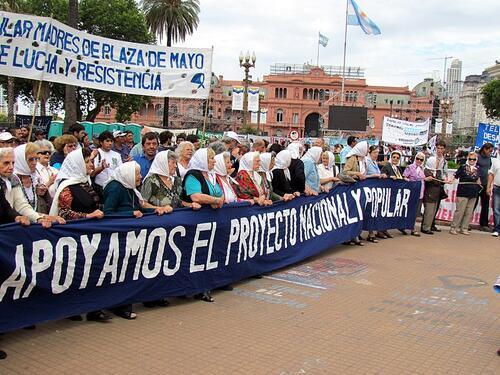
The disproportionate numbers of Jews among those who disappeared during the "Dirty War" accounts for the relatively large numbers of Jewish women making up the Mothers of the Plaza de Mayo. During the “Dirty War,” Jewish mothers of those who disappeared also protested outside the Ashkenazi community center, demanding that it intercede with the regime.
After World War II and especially after the 1960s, Jewish women assumed more visible positions in communal organizations. They also figured disproportionately in the leftist guerrillas active in the 1960s and 1970s and the student circles that nourished them. During its “Dirty War” against terrorism, the military dictatorship of 1976–1983 repressed, tortured, and “disappeared” the guerrillas, as well as leftists, students, workers, and members of the intelligentsia. Their strong presence in these sectors, as well as the antisemitism of the security forces, explains why Jews, who were less than one percent of the population, amounted to about ten percent of the disappeared. All prisoners received brutal treatment, but Jews were subject to particular abuse, frequently accompanied by Nazi slogans. Guards raped and wielded extraordinary power over female detainees, whom they did not regard as “true women.” As Jews and women, Jewish women prisoners suffered inordinately.
The loss of their children sparked Jewish women into action. The disproportionate numbers of Jews among the disappeared accounts for the relatively large numbers of Jewish women among the courageous Mothers of the Plaza de Mayo, who sought information about their missing children and demonstrated in front of the presidential palace from 1977 on. During the “Dirty War,” mothers of the Jewish disappeared also stood before the AMIA Ashkenazi community center, demanding that it intercede with the regime.
Jewish women helped build families, communities, and identities. Women of diverse backgrounds strengthened bonds among Argentine Jews, and between them and the Argentine and nascent Israeli states. As pioneer farmers, political activists, union members, performers, human rights advocates, and prostitutes, Jewish women participated in some of the most dramatic spectacles of Argentine history. They created ideals of social justice that continue to inspire Jews and Catholics alike.
Avni, Haim. Argentina and the Jews: A History of Jewish Immigration. Tuscaloosa, Alabama: 1991.
Bortnik de Duchovny, Dora. Recuerdos de una maestra de campaña. San Isidro, Argentina: Instituto Dr. Juan S. Fernández, 1980.
Brodsky, Adriana. Sephardi, Jewish, Argentine: Community and National Identity, 1880-1960.
Bloomington, IN: Indiana University Press, 2016.
Deutsch, Sandra McGee. “Women: The Forgotten Half of Argentine Jewish History.” Shofar 15 (Spring 1997): 49–63.
Deutsch, Sandra McGee. Crossing Borders, Claiming a Nation: A History of Argentine
Jewish Women, 1880-1955. Durham: Duke University Press, 2010.
Deutsch, Sandra McGee. "Argentine Women Against Fascism: The Junta de la Victoria, 1941-
1947." Politics, Religion & Ideology 13, no. 2 (2012): 221-36.
Edelman, Fanny. Banderas. Pasiones. Camaradas. Buenos Aires: Ediciones Dirple
1996.
Elnecavé, Bruria. Crisol de vivencias judías. Buenos Aires: La Luz, 1994.
Foster, David William. “Recent Argentine Women Writers of Jewish Descent.” In Passion, Memory, and Identity: Twentieth-Century Latin American Jewish Women Writers, edited by Marjorie Agosín, 35–57. Albuquerque: University of New Mexico Press, 1999.
Glickman, Nora. The Jewish White Slave Trade and the Untold Story of Raquel Liberman. New York: Routledge, 1999.
Guy, Donna J. Sex and Danger: Prostitution, Family, and Nation in Argentina. Lincoln: University of Nebraska Press, 1991.
Yarfitz, Mir. Impure Migration: Jews and Sex Work in Golden Age Argentina. New
Brunswick: Rutgers University Press, 2019.
Kaufman, Edy. “Jewish Victims of Repression in Argentina under Military Rule (1976–1983).” Holocaust and Genocide Studies 4 (1989): 479–99.
Levenson, Raquel. Ejemplo de mujer revolucionaria argentina. Buenos Aires: Frente Unico, 1972
Mirelman, Victor A. Jewish Buenos Aires, 1890–1930: In Search of an Identity. Detroit: Wayne State University Press, 1990.
Partnoy, Alicia. The Little School: Tales of Disappearance & Survival in Argentina. Pittsburgh and San Francisco: Cleis Press, 1986.
Singerman, Berta. Mis dos vidas. Buenos Aires: Ediciones Tres Tiempos, 1981.
Visacovsky, Nerina. "La identidad política de las mujeres judeo-argentinas (1947-1957)." In V
Congreso Latinoamericano de Ciencia Política. Buenos Aires: Acta Académica, 2010.

